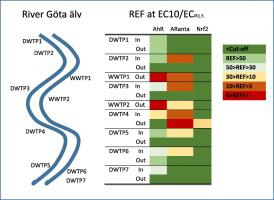Science of the Total Environment ( IF 9.8 ) Pub Date : 2020-12-04 , DOI: 10.1016/j.scitotenv.2020.144001 Agneta Oskarsson , Anna Kjerstine Rosenmai , Geeta Mandava , Anders Johannisson , Andrew Holmes , Rikard Tröger , Johan Lundqvist

|
Drinking water quality and treatment efficacy was investigated in seven drinking water treatment plants (DWTPs), using water from the river Göta Älv, which also is a recipient of treated sewage water. A panel of cell-based bioassays was used, including measurements of receptor activity of aryl hydrocarbon (AhR), estrogen (ER), androgen (AR), peroxisome proliferator-activated receptor alpha (PPARα) as well as induction of oxidative stress (Nrf2) and micronuclei formation. Grab water samples were concentrated by solid phase extraction (SPE) and water samples were analyzed at a relative enrichment factor of 50. High activities of AhR, ER and AR antagonism were present in WWTP outlets along the river. Inlet water from the river exhibited AhR and AR antagonistic activities. AhR activity was removed by DWTPs using granulated activated carbon (GAC) and artificial infiltration. AR antagonistic activitywas removed by the treatment plants, except the artificial infiltration plant, which actually increased the activity. Furthermore, treated drinking water from the DWTP using artificial infiltration exhibited high Nrf2 activity, which was not found in any of the other water samples. Nrf2 activity was found in water from eight of the 13 abstraction wells, collecting water from the artificial infiltration. No genotoxic activity was detected at non-cytotoxic concentrations. No Nrf2 or AR antagonistic activities were detected in the inlet or outlet water after the DWTP had been replaced by a new plant, using membrane ultrafiltration and GAC. Neither target chemical analysis, nor chemical analysis according to the drinking water regulation, detected any presence of chemicals, which could be responsible of the prominent effects on oxidative stress and AR antagonistic activity in the drinking water samples. Thus, bioanalysis is a useful tool for detection of unknown hazards in drinking water and for assessment of drinking water treatments.
中文翻译:

通过体外生物测定评估七个饮用水处理厂的水源和处理后的水质-人工渗透后的氧化应激和抗雄激素作用
在七个饮用水处理厂(DWTP)中,使用了来自GötaÄlv河的水进行了调查,该河也是经过处理的污水的接收者。使用了一组基于细胞的生物测定法,包括测量芳烃(AhR),雌激素(ER),雄激素(AR),过氧化物酶体增殖物激活受体α(PPARα)的受体活性以及氧化应激的诱导(Nrf2 )和微核形成。通过固相萃取(SPE)浓缩抓取的水样品,并以50的相对富集因子分析水样品。沿河的WWTP出口处存在高活性的AhR,ER和AR拮抗作用。从河中流入的水表现出AhR和AR拮抗作用。使用颗粒状活性炭(GAC)和人工渗透,通过DWTP去除了AhR活性。除人工渗透植物外,AR拮抗活性已被处理植物去除,而后者实际上增加了活性。此外,来自DWTP的经过人工渗透处理的饮用水显示出高的Nrf2活性,这在其他任何水样中均未发现。在13口提取井中的8口水中发现Nrf2活性,并从人工渗透中收集水。在非细胞毒性浓度下未检测到遗传毒性活性。使用膜超滤和GAC将DWTP替换为新工厂后,在进水或出水中未检测到Nrf2或AR拮抗活性。既不进行目标化学分析,也不根据饮用水法规进行化学分析,检测到任何化学物质的存在,这可能是对饮用水样品中氧化应激和AR拮抗活性的重要影响。因此,生物分析是检测饮用水中未知危害和评估饮用水处理的有用工具。



























 京公网安备 11010802027423号
京公网安备 11010802027423号